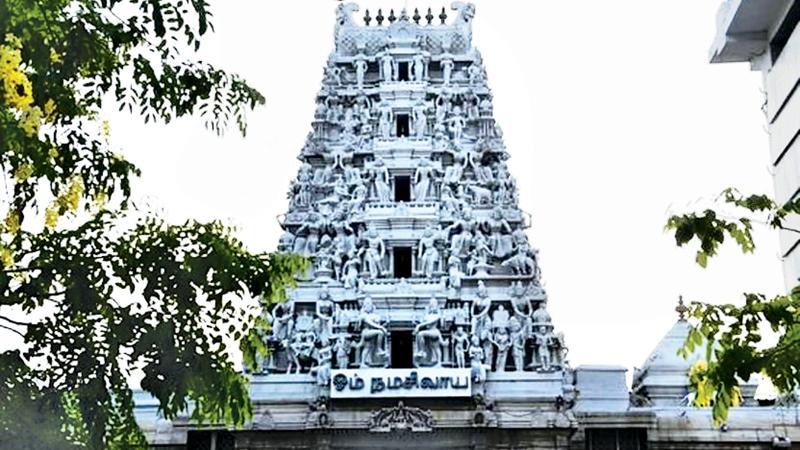
The first impression is stunning, rows and rows of stone columns stood, bathed in the light of oil lamps. The stone structure is adorned with many idols and mascots related to Hinduism
One of the most magnificent Hindu kovils in the island is located at Kochchikade: which is the cradle of many religious venues. This edifice manifesting the finest forms of Dravidian design and art in total  granite is commonly known as the Kochchikade Sivan kovil, but its real name is Sri Ponnambalavaneswara Devasthanam (sacred sanctuary) wherein is enshrined Sri Sivagama Sounthari Ambal (female deity) and Samedha Sornasabeswara Swamy (male deity). For more than 150 years this kovil has been an iconic landmark for devotees and tourists. Its massive structure supplemented by picture perfect gardens is one unique aspect.
granite is commonly known as the Kochchikade Sivan kovil, but its real name is Sri Ponnambalavaneswara Devasthanam (sacred sanctuary) wherein is enshrined Sri Sivagama Sounthari Ambal (female deity) and Samedha Sornasabeswara Swamy (male deity). For more than 150 years this kovil has been an iconic landmark for devotees and tourists. Its massive structure supplemented by picture perfect gardens is one unique aspect.
I visited the kovil on Friday, a day venerated by the Hindu community. The kovil was resonating with the sound of bells and vibrant drumbeat. As you enter from the rear gate (opposite the Colombo harbour) you see large cows in shades of white, brown and black. These docile animals make a silent contribution to the rituals of worship (kosalai): their unblemished milk is used in the inner sanctum of the kovil.
Finding directions to the manager’s office I met up with Chithrakanapathy Senthur, who has been a faithful devotee first, and now, an administrator. According to legend Ponnambalam Mudaliyar had dreamt that he was given a pomegranate fruit, which when split in half revealed a sacred Sivalingam.
Mesmerized by this vision he was determined to build a kovil. He is said to have purchased a land, at that time laden with coconut trees, from Captain John Strone. By 1857 basic work was undertaken to establish a shrine and the ritual of Kumbabishekam performed. By 1907, Sir Ponnambalam Ramanathan began a detailed building plan, for which huge slabs of cut granite were procured to Colombo.
This was a massive building operation with hundreds of skilled workers and stone cutters. By November 1912 to the delight of thousands of devotees the Sivan kovil was firmly established. As the fame of the kovil spread, in 1967 a Rajagopuram (tower) was built on the east side entrance. The gopuram is saturated with many idols.
Walking in the spacious garden Senthur points to the theertha kerni - an open pond which is reached by steps. The water in this pond is used in ritual worship. After reaching the main door and gently washing our feet we enter the kovil.
The first impression is stunning, rows and rows of stone columns stood, bathed in the light of oil lamps. The stone structure is adorned with many idols and mascots related to Hinduism. A bevy of Tamil girls smile and pass by, carrying oil lamps and silver trays loaded with fruits. An old priest welcomes me with clasped hands.
He points out to a well that lies inside the kovil, and says the water of this well has not gone dry for more than a century. By now people start coming in for the pooja - there are six poojas every day conducted by nine clergy. We go past the Vasantha mandapam, where there are 5 deity, namely, a venerated Vinayagar, Murugan, Somaskandar, Amman and Sundeswaran. As we near the Maha mandapam - which is the innermost place there is total silence.
Through an iron grill one can see the Nithiya akkini kundam- an eternal flame, the only kovil in the country that keeps this alight. On the right side of the sanctum there are animals and birds - sculpted in wood and mounted on wheels. These designs include a horse, cow (nandi), goat and peacock.
As we enter the garden again, we are able to take a peek at the kovil chariot. The Sivan kovil which commenced the 10 day Mahotchava festival on March 19 will culminate it with a grand pooja on March 29, which draws thousands of men, women and children, annually. Gazing at the kovil roof from outside I am able to see the ‘Duwarapalagar”- warrior sentinels engraved boldly in granite, quite an imposing sight.
The present temple chief trustee is Minister of Hindu Cultural Affairs, D.M. Swaminathan. The kovil has a large reception hall patronized by Buddhists and Hindus. The Sivan kovil has stood as a radiant beacon of hope to her devotees, sustaining traditions and rituals enhancing the beautiful multi-ethnic mix of Colombo.
